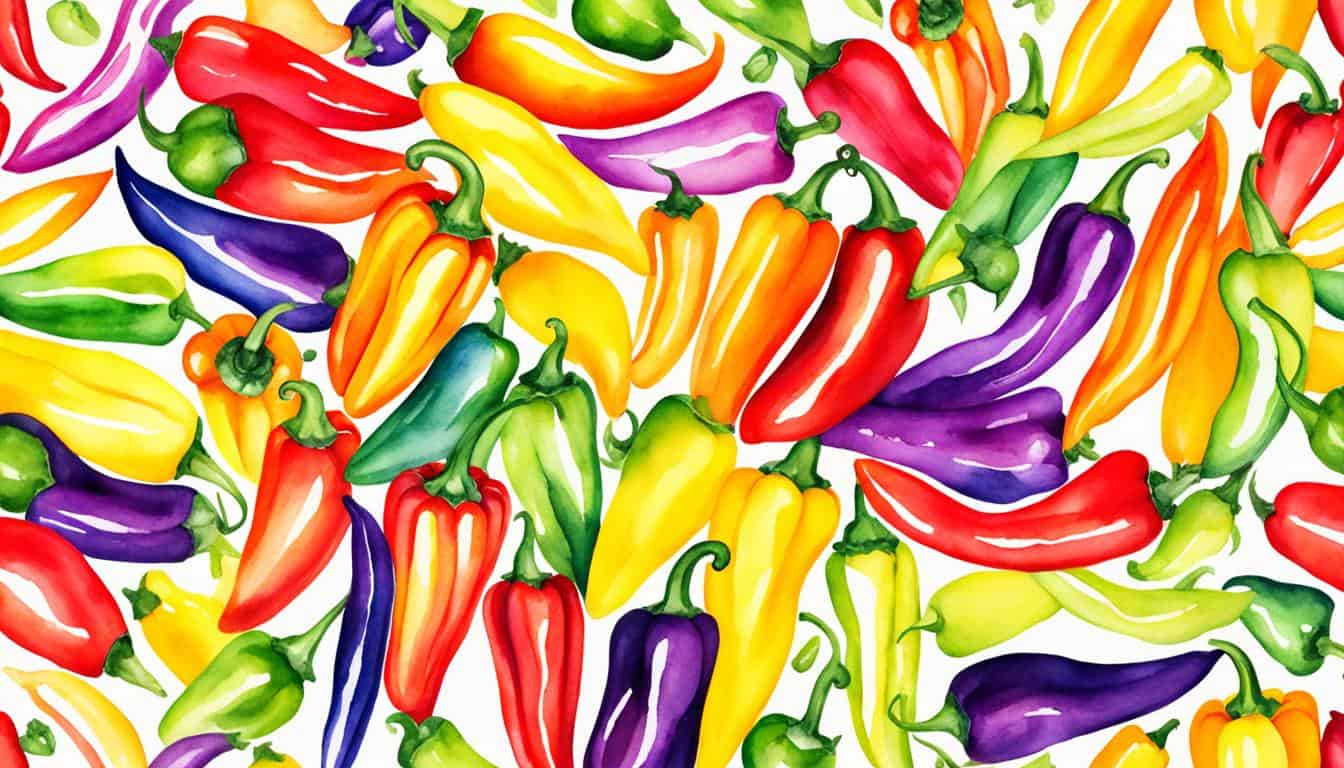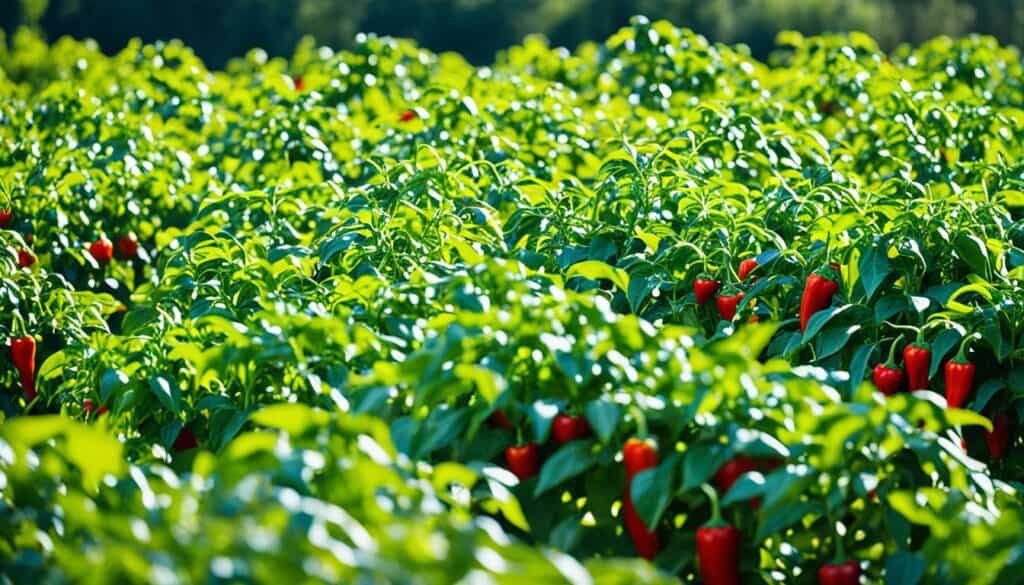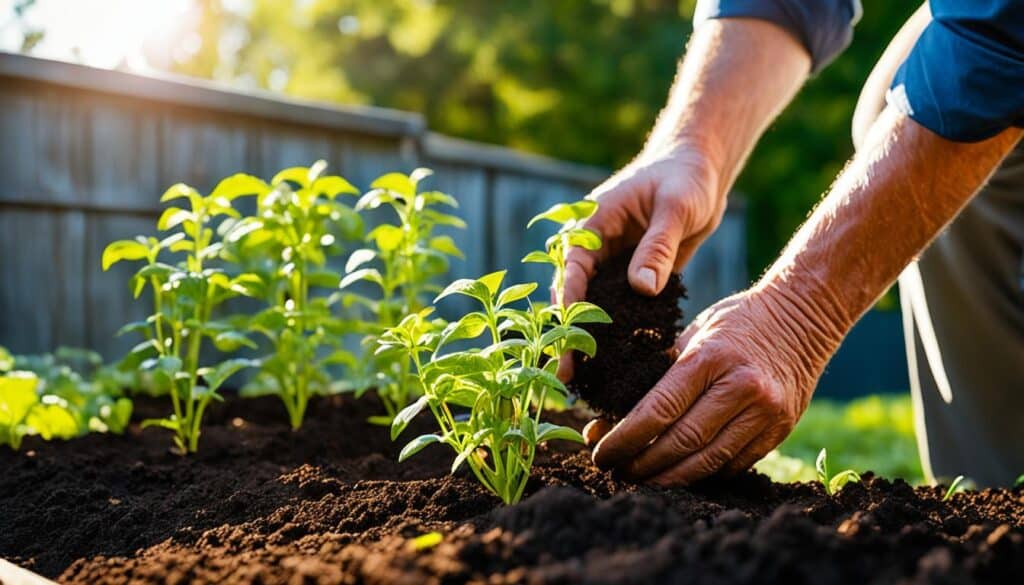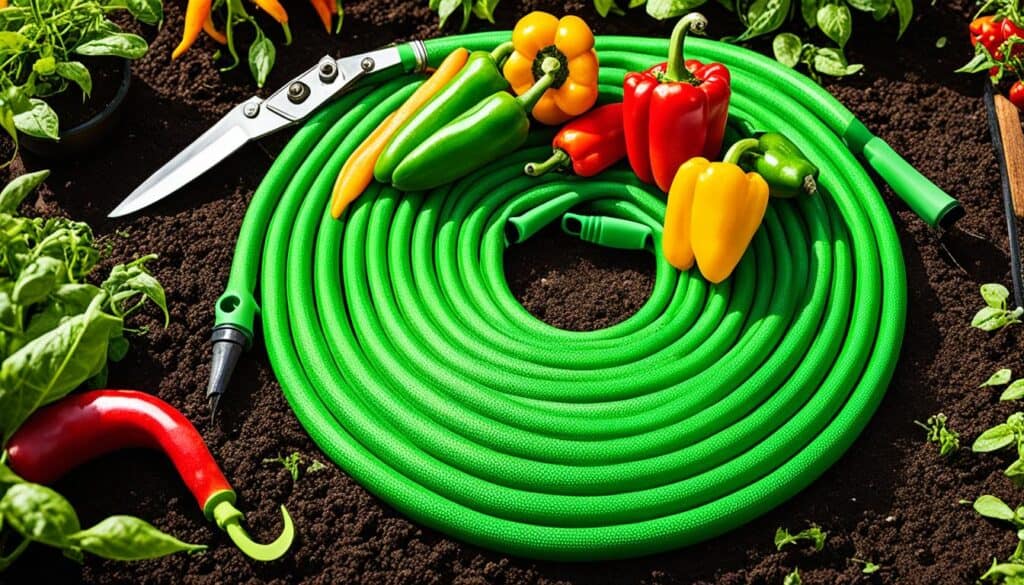Did you know that sweet peppers are not just limited to the familiar green variety? In fact, there are a stunning array of colors to choose from, including vibrant reds, sunny yellows, and even deep purples. With their bright hues and delicious flavors, sweet peppers can add a pop of freshness to any dish. Whether you’re a seasoned gardener or a novice, growing sweet peppers can be a rewarding endeavor. In this article, I will share my secrets for successfully growing and enjoying a bountiful harvest of garden-fresh sweet peppers.
Key Takeaways:
- There are various colors of sweet peppers to choose from, including red, yellow, and purple.
- Growing sweet peppers can be a rewarding experience for gardeners of all levels.
- In this article, I will share tips and tricks for successfully growing and enjoying sweet peppers in your garden.
- Choosing the right varieties, providing proper care and maintenance, and knowing when to harvest are key factors for a successful harvest.
- With these tips, you can enjoy a vibrant and healthy harvest of sweet peppers for all your culinary creations.
The Difference Between Red and Green Peppers
When it comes to sweet peppers, there’s a stark contrast between the flavors of red and green peppers. Red peppers are bursting with sweetness and flavor, while green peppers are the underripe version, lacking the same taste and sweetness.
The flavor difference between red and green peppers is remarkable. Green peppers tend to be more bland and fibrous, with a milder taste compared to their ripe counterparts. In contrast, ripe red peppers are juicy, tender, and irresistibly sweet with a slightly acidic undertone.
The flavor of red peppers is truly delightful. Their natural sweetness enhances any dish, adding depth and complexity to salads, stir-fries, and even roasted dishes.
When harvesting peppers for the best taste experience, it’s recommended to wait until they turn red, yellow, or orange. This allows the peppers to fully develop their flavor and sweetness. While green peppers have their uses in certain recipes, ripe red peppers are a true culinary delight.
Comparison of Red and Green Peppers
| Aspect | Red Peppers | Green Peppers |
|---|---|---|
| Taste | Sweet, tangy, and slightly acidic | Mild, slightly bitter, and fibrous |
| Texture | Juicy and tender | Crunchy and firm |
| Color | Red, yellow, or orange | Green |
| Uses | Versatile in salads, stir-fries, roasting, and grilling | Suitable for stuffing, pickling, and baking |
As you can see, the differences between red and green peppers go beyond just color. Their taste, texture, and uses diverge, making them ideal for different culinary creations. Whether you’re looking for a naturally sweet addition to a salad or a mildly tangy flavor in stuffed peppers, knowing the difference between red and green peppers will elevate your cooking to new heights.
Best Varieties of Sweet Peppers
When it comes to growing sweet peppers, choosing the right varieties is key. Some of the best varieties for sweet peppers include:
- Carmen: A sweet Italian frying pepper that produces an abundance of red peppers on each plant. It is known for its exceptional taste and prolific fruit production.
- Jimmy Nardello: An heirloom variety famous for its incredibly sweet and rich flavor. These peppers are a true delight for any culinary creation.
- Tequila Sunrise: A carrot-shaped orange pepper that boasts multiple fruits on one plant. Its vibrant color and sweet taste make it a favorite among gardeners.
- Escamillo: Bred by the same person as Carmen, this yellow pepper is known for its long Italian frying peppers. It offers a delightful taste and abundant fruit production.
Each of these varieties brings something unique to the table, whether it’s the vibrant colors, sweet flavors, or exceptional fruit production. By growing these varieties, you can enjoy a diverse range of sweet peppers in your garden and elevate your culinary creations.
Stay tuned for the next section, where I will share valuable insights on where to find high-quality pepper plants, whether you want to start your own or purchase them.
Where to Find Pepper Plants
If you’re eager to start growing your own pepper plants, you have a couple of options: starting from seeds or purchasing established plants. Starting your own plants from seeds allows you to have complete control over the growing process and provides the opportunity to experiment with different varieties. On the other hand, if you prefer convenience or are looking for specific pepper plant varieties, buying established plants is a great option.
If you choose to start your own plants, you can find a wide variety of pepper seeds at your local garden center or nursery. Additionally, many online seed suppliers offer an extensive selection of pepper seeds, with detailed descriptions and growing instructions. This way, you can find the exact varieties you desire and even try some heirloom or unique pepper varieties.
If you opt for purchasing pepper plants, it is best to source them from local farmers markets, specialized nurseries, or reputable plant sellers. Buying from these sources ensures that the plants are well-suited to your local climate and have been grown with care. Avoid buying pepper plants from large chain stores, as they may not carry a wide variety of options and the plants might not be perfectly adapted to your specific location.
When selecting pepper plants, look for healthy, robust plants with no signs of disease or pest damage. Choose plants with sturdy stems and a healthy root system. It’s also a good idea to ask the seller for information about the plant’s care, including watering requirements, sunlight preferences, and potential pests or diseases to watch out for.
Whether you decide to start your own pepper plants or purchase them, remember to provide optimal growing conditions, such as proper soil, adequate sunlight, and regular watering, to ensure healthy and productive plants. With a little patience and care, you’ll soon be enjoying a bountiful harvest of flavorful peppers right from your own garden.
When and How to Plant Peppers
Planting peppers requires careful consideration of temperature and spacing to ensure successful growth and a bountiful harvest. Here are some essential guidelines to follow:
1. Timing:
Peppers are sensitive to low temperatures and should not be planted until all danger of frost has passed. Waiting until after the last frost date in your area ensures that the soil and air temperatures are consistently above 60 degrees Fahrenheit, which is ideal for pepper growth.
2. Soil and Sun:
Choose a well-drained soil with a pH level between 6.0 and 6.8 for optimal pepper growth. Peppers thrive in full sunlight, so select a location that receives at least 6 to 8 hours of direct sunlight per day.
3. Spacing:
Proper spacing is crucial for pepper plants to have adequate room to grow and receive nutrients. Plant peppers 12 to 18 inches apart within rows spaced 24 to 36 inches apart. This spacing allows for good air circulation and prevents overcrowding, reducing the risk of common pepper diseases.
4. The Planting Process:
When planting peppers, follow these steps:
- Prepare the soil by loosening it with a garden fork or tiller.
- Add compost or well-rotted manure to enrich the soil.
- Dig a hole slightly larger than the root ball of the pepper plant.
- Place the plant in the hole and backfill with soil, ensuring that the plant is at the same level as it was in the container.
- Gently firm the soil around the plant to eliminate air pockets.
- Water thoroughly after planting to settle the soil.
Now you’re ready to plant your peppers and watch them thrive!
For a visual reference, here’s a table summarizing the key points:
| Aspect | Guidelines |
|---|---|
| Timing | Plant after the last frost date, when soil and air temperatures are consistently above 60°F. |
| Soil and Sun | Choose well-drained soil with a pH level between 6.0 and 6.8. Plant in a sunny location with 6 to 8 hours of direct sunlight per day. |
| Spacing | Plant peppers 12 to 18 inches apart in rows spaced 24 to 36 inches apart. |
| The Planting Process | – Prepare the soil – Add compost or manure – Dig a proper hole – Plant the pepper – Firm the soil – Water thoroughly |
Refer to the table above to ensure the best planting conditions for your pepper plants.
Plant Care and Maintenance
To ensure healthy growth and abundant fruit production in your sweet peppers, it’s important to provide them with proper care and maintenance. Here are some essential tasks to keep in mind:
Fertilizer:
Use balanced organic fertilizers to nourish your pepper plants. Avoid excessive nitrogen, as it can lead to leafy growth but minimal fruiting. Opt for a fertilizer with a balanced NPK ratio to promote overall plant health and encourage fruit development.
Mulching:
Mulching around your pepper plants can help retain moisture in the soil, preventing it from drying out quickly. Mulch also acts as a barrier, reducing weed growth and keeping the pepper fruits clean. Apply a layer of organic mulch, such as straw or wood chips, around the base of the plants.
Watering:
Consistent soil moisture is crucial for the well-being of pepper plants. Water your plants regularly, aiming for about 1 inch of water per week. However, make sure not to overwater, as this can lead to root rot. Monitor the soil moisture levels and adjust your watering schedule accordingly.
Staking:
As pepper plants grow and produce fruits, they may become top-heavy and prone to bending or breaking. To prevent this, stake your pepper plants using bamboo stakes or other supportive structures. Gently tie the stems to the stakes with soft string or plant ties, ensuring they have enough room to expand.
Temperature:
Pepper plants thrive in warm temperatures, ideally between 70-85 degrees Fahrenheit (21-29 degrees Celsius). Avoid exposing your plants to extreme heat or cold, as it can negatively impact fruit set and overall yield. Consider using row covers or shade cloth to protect your plants during hot summer days or unexpected temperature drops.
By following these care and maintenance practices, you can provide your sweet pepper plants with the optimal growing conditions they need to thrive and produce an abundance of flavorful fruits.
When and How to Harvest Peppers
Harvesting peppers at the right time is crucial to enjoy their optimal flavor and nutritional benefits. Whether you prefer green, red, yellow, or orange peppers, knowing when they are ripe and how to handle them is essential. Here’s a guide on when and how to harvest peppers:
Harvesting Ripe Peppers
Peppers can be harvested when they reach their desired color, indicating ripeness. Ripe peppers are not only sweeter but also have a higher vitamin content compared to unripe peppers. Take note of the following guidelines:
- The ripeness of red, yellow, and orange peppers is easily determined by the deep and vibrant color they exhibit.
- Green peppers are the unripe variety and have a milder flavor compared to their ripe counterparts.
- To ensure optimal taste and quality, it’s recommended to wait until peppers fully change color before harvesting.
- Gently press the pepper to check if it feels firm. Ripe peppers will be plump and slightly soft.
Once you’ve confirmed peppers are ripe, it’s time to harvest them properly.
Harvesting Technique
When harvesting peppers, it’s best to use pruning shears or a sharp knife to avoid damaging the plants. Follow these steps:
- Locate the stem of the pepper, where it connects to the plant.
- Hold the pepper with one hand or support it slightly with the other hand.
- Position your shears or knife close to the stem, leaving a short stub (about 1/2 inch) attached to the pepper.
- Make a clean cut to detach the pepper from the plant.
By leaving a short stub of stem, you prevent potential damage to the pepper and encourage longer storage life.
Storing Peppers
To maintain the freshness and quality of your harvested peppers, proper storage is essential. Here are some tips:
Tip: Store harvested peppers in the refrigerator to extend their shelf life.
For green peppers:
- Place them in a perforated plastic bag or airtight container in the refrigerator.
- Green peppers can continue to ripen indoors for a few days, gradually changing color.
- Use them promptly once they reach the desired color for optimal taste.
For fully ripe peppers:
- Refrigerate them immediately to maintain freshness.
- Use ripe peppers within a few days to maximize their flavor and texture.
By following these guidelines, you can enjoy the delicious taste and nutritional benefits of freshly harvested peppers!
Best Pepper Varieties for Different Purposes
In addition to traditional bell peppers, there are various specialty peppers that offer unique flavors and heat levels. Here are some popular choices:
- ‘Ace’ – Ideal for early red bell peppers, this variety matures quickly and produces sweet and crisp peppers.
- ‘Olympus’ – Known for its large size and versatility, ‘Olympus’ starts as green bells and matures into sweet and vibrant red peppers.
- ‘Flavorburst’ – If you’re looking for sweet yellow peppers, ‘Flavorburst’ is a fantastic choice. These peppers are crisp, juicy, and offer a burst of flavor.
- ‘Lunchbox’ – For a fun and convenient snack, try ‘Lunchbox’ peppers. These small-sized peppers come in various colors, including red, yellow, and orange.
- ‘Carmen’ and ‘Escamillo’ – If you enjoy sweet Italian frying peppers, both ‘Carmen’ and ‘Escamillo’ are excellent options. These elongated peppers are perfect for grilling or sautéing.
- ‘Mellow Star’ – For those who prefer mild heat, ‘Mellow Star’ is a mild Japanese shishito pepper. These thin-skinned peppers have a slight smoky flavor and are fantastic for stir-fries or blistering.
Choosing the right pepper varieties ensures a diverse range of flavors and opens up endless culinary possibilities in the kitchen.
Conclusion
Growing garden-fresh sweet peppers can be a delightful and fulfilling endeavor. By following these tips and tricks, you can enhance your success and enjoy a plentiful harvest of vibrant and healthy sweet peppers.
First and foremost, select the sweet pepper varieties that align with your taste preferences. Whether you’re drawn to the rich sweetness of ‘Carmen’ or the flavorful complexity of ‘Jimmy Nardello,’ there’s a wide array of choices to cater to your culinary needs.
Next, prioritize proper care and maintenance. From providing well-balanced, organic fertilizers to mulching for moisture retention, these practices will ensure robust growth and fruitful production. Remember to monitor temperature conditions and provide adequate support through staking.
Lastly, harvesting sweet peppers at their peak ripeness is paramount. Whether you prefer green, red, yellow, or orange peppers, wait for them to reach their desired color. Harvesting with precision and storing correctly will preserve their freshness and nutritional value, allowing you to savor the flavors in your favorite recipes.









Leave a Reply